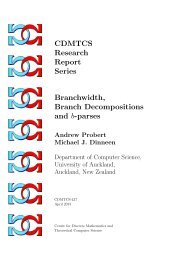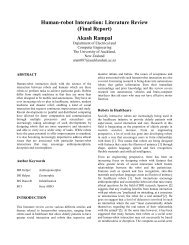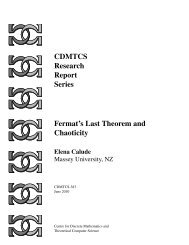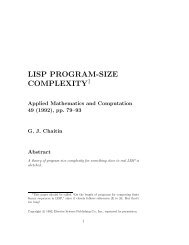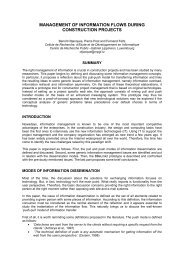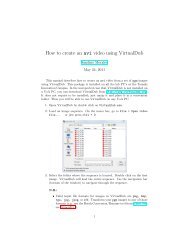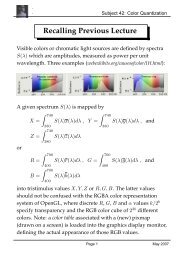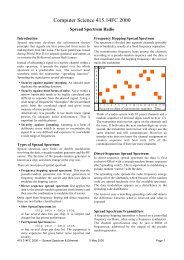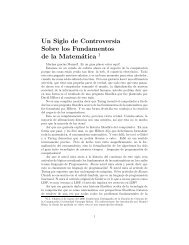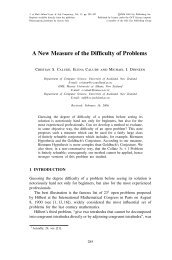Workshop on Truths and Proofs - Department of Computer Science
Workshop on Truths and Proofs - Department of Computer Science
Workshop on Truths and Proofs - Department of Computer Science
You also want an ePaper? Increase the reach of your titles
YUMPU automatically turns print PDFs into web optimized ePapers that Google loves.
CDMTCS<br />
Research<br />
Report<br />
Series<br />
<str<strong>on</strong>g>Workshop</str<strong>on</strong>g> <strong>on</strong> <strong>Truths</strong> <strong>and</strong><br />
<strong>Pro<strong>of</strong>s</strong><br />
D. S. Bridges, C. S. Calude,<br />
F. Kro<strong>on</strong> (Eds.)<br />
Christchurch University<br />
University <strong>of</strong> Auckl<strong>and</strong><br />
New Zeal<strong>and</strong><br />
CDMTCS-165<br />
November 2001<br />
Centre for Discrete Mathematics <strong>and</strong><br />
Theoretical <strong>Computer</strong> <strong>Science</strong>
The Centre for Discrete Mathematics <strong>and</strong> Theoretical <strong>Computer</strong> <strong>Science</strong><br />
<strong>and</strong> The <strong>Department</strong> <strong>of</strong> Philosophy<br />
WORKSHOP ON TRUTHS AND PROOFS<br />
Auckl<strong>and</strong>, 7-8 December 2001<br />
The <str<strong>on</strong>g>Workshop</str<strong>on</strong>g> is part <strong>of</strong> the Australasian Associati<strong>on</strong> <strong>of</strong> Philosophy (New Zeal<strong>and</strong> Divisi<strong>on</strong>) Annual<br />
C<strong>on</strong>ference to be held in Auckl<strong>and</strong>, New Zeal<strong>and</strong> <strong>on</strong> 2-7 December 2001.<br />
The <str<strong>on</strong>g>Workshop</str<strong>on</strong>g> c<strong>on</strong>sists <strong>of</strong> seven talks <strong>and</strong> <strong>on</strong>e roundtable discussi<strong>on</strong>. The programme, including the<br />
abstracts <strong>of</strong> talks, follows.
Friday: 7 December 2001.<br />
Morning Sessi<strong>on</strong>: Room 421, 55 Anzac Ave.<br />
10.00am–10.15am: Opening<br />
SESSION I Chair: Koji Tanaka<br />
Programme<br />
10.15am-11.00am: Philip Catt<strong>on</strong>. <strong>Pro<strong>of</strong>s</strong>, Harm<strong>on</strong>y, Meaning<strong>and</strong> Truth<br />
Abstract: Suppose that we were to illustrate Michael Dummett’s view <strong>of</strong> meaning <strong>and</strong> truth in<br />
mathematics by comparing asserti<strong>on</strong>s <strong>of</strong> mathematics with asserti<strong>on</strong>s <strong>of</strong> physics. To produce a good<br />
underst<strong>and</strong>ing, with respect to physics, <strong>of</strong> the doctrine about meaning that Dummett spells out with<br />
respect to mathematics, we would need to say things about physics that are, from the vantage point <strong>of</strong><br />
philosophers <strong>of</strong> physics, roughly fifty years out <strong>of</strong> date, that is, utterly bey<strong>on</strong>d the pale by now because<br />
<strong>of</strong> the advancement over recent decades <strong>of</strong> our philosophical underst<strong>and</strong>ing <strong>of</strong> physics. This raises doubts<br />
in my mind about Dummett’s view, <strong>and</strong> the doubts that it raises seem to me well directed towards an<br />
alternative to that view. Yet the alternative is not <strong>on</strong>e that I think has been canvassed by philosophers <strong>of</strong><br />
mathematics. It seems to me therefore that the philosophy <strong>of</strong> mathematics could usefully learn something<br />
from the philosophy <strong>of</strong> physics. And if that is so then, via the link between mathematics <strong>and</strong> meaning<br />
established inter alii by Dummett, we might find the less<strong>on</strong>s we learn about mathematics pertinent to<br />
our general views about meaning <strong>and</strong> truth.<br />
Proceeding in this way I shall take a step away from Dummett, but not so large a step as to dispel<br />
altogether the vestiges <strong>of</strong> verificati<strong>on</strong>ism that there are in his positi<strong>on</strong> or therefore so large as to l<strong>and</strong><br />
me in the realist camp. If I am not mistaken, the noti<strong>on</strong>s <strong>of</strong> meaning <strong>and</strong> truth could remain epistemic<br />
<strong>and</strong> yet possess qualities c<strong>on</strong>spicuously different from those that either Dummett or his holist antag<strong>on</strong>ist<br />
Quine bring into view.<br />
According to a raw verificati<strong>on</strong>ist outlook <strong>on</strong> physics, a theory <strong>of</strong> physics, ins<strong>of</strong>ar as it is meaningful<br />
<strong>and</strong> true, accurately predicts what we observe. C<strong>on</strong>temporary philosophy <strong>of</strong> physics corrects this view at<br />
least to the extent <strong>of</strong> replacing ’accurately predicts’ by ’c<strong>on</strong>certedly harm<strong>on</strong>ises’ <strong>and</strong> ’what we observe’ by<br />
’phenomena’. A theory <strong>of</strong> physics ins<strong>of</strong>ar as it is meaningful <strong>and</strong> true c<strong>on</strong>certedly harm<strong>on</strong>ises phenomena.<br />
A phenomen<strong>on</strong> is as far different from what we might observe as c<strong>on</strong>certed harm<strong>on</strong>isati<strong>on</strong> is from mere<br />
accuracy <strong>of</strong> predicti<strong>on</strong>, <strong>and</strong> the differences are very similar. Phenomena have a richness far <strong>and</strong> away<br />
bey<strong>on</strong>d what can be brought under simple observati<strong>on</strong>, yet phenomena also possess robust c<strong>on</strong>silience<br />
features which remark a kind <strong>of</strong> harm<strong>on</strong>y in what they draw together.<br />
<strong>Pro<strong>of</strong>s</strong> promote rati<strong>on</strong>al harm<strong>on</strong>y in a science; such harm<strong>on</strong>y is impossible without pro<strong>of</strong>s. Thus the<br />
epistemology <strong>of</strong> physics invites attenti<strong>on</strong> to the nexus <strong>of</strong> pro<strong>of</strong>s, harm<strong>on</strong>y, meaning <strong>and</strong> truth. I indicate<br />
why I think that the same nexus is important for the philosophy <strong>of</strong> mathematics, <strong>and</strong> indeed for the<br />
general underst<strong>and</strong>ing <strong>of</strong> meaning <strong>and</strong> truth.<br />
11.00am–11.15am: C<strong>of</strong>fee break<br />
11.15am–12.00pm: Bill Bart<strong>on</strong>. Truth, Tautology, or Just Being Sensible? Some Reflecti<strong>on</strong>s Deriving<br />
from Wittgenstein’s Ideas about Mathematical Talk<br />
Abstract: The last forty years has seen increasing interest in mathematics as a cultural phenomen<strong>on</strong>.<br />
However st<strong>and</strong>ard positi<strong>on</strong>s in the philosophy <strong>of</strong> mathematics are at odds with such a view. If mathematics<br />
has a claim to any absolute or universal st<strong>and</strong>ard <strong>of</strong> rati<strong>on</strong>ality or truth, then mathematics<br />
cannot simply be a form <strong>of</strong> cultural expressi<strong>on</strong>.<br />
2
This paper will discuss the shift in philosophical orientati<strong>on</strong> which is required by a cultural view<br />
<strong>of</strong> mathematics, <strong>and</strong> the c<strong>on</strong>sequences for noti<strong>on</strong>s <strong>of</strong> truth <strong>and</strong> rati<strong>on</strong>ality. Wittgenstein’s explorati<strong>on</strong>s<br />
<strong>of</strong> mathematical talk will be used to explore ideas <strong>of</strong> truth <strong>and</strong> pro<strong>of</strong> with respect to some elementary<br />
mathematical examples.<br />
12.15pm–1.30pm: Lunch, Room 514, Fisher Internati<strong>on</strong>al Building, 18 Waterloo Quadrant<br />
Friday: 7 December 2001.<br />
Early Afterno<strong>on</strong> Sessi<strong>on</strong>: Room 611, Fisher Internati<strong>on</strong>al Building<br />
SESSION II Chair: Douglas Bridges<br />
2.00pm–2.45pm: Tien D. Kieu. Quantum Principles <strong>and</strong> Mathematical Computability<br />
Abstract: The limits <strong>of</strong> mathematical computability have been set solely by mathematical logic <strong>and</strong><br />
reas<strong>on</strong>ing until now. Here we propose a quantum mechanical “algorithm” for <strong>on</strong>e <strong>of</strong> the insoluble problems<br />
<strong>of</strong> mathematics, the Hilbert’s tenth <strong>and</strong> equivalently the Turing halting problem. The algorithm, as<br />
it st<strong>and</strong>s, has its limit as it cannot solve n<strong>on</strong>-computable problems <strong>of</strong> other classes different than that <strong>of</strong><br />
Turing’s. But it provides an interesting <strong>and</strong> new perspective <strong>on</strong> computability. If for some fundamental<br />
physical principles or unsatisfiable requirements <strong>of</strong> physical resources (c<strong>on</strong>strained by the total energy<br />
<strong>and</strong> lifetime <strong>of</strong> the universe) the algorithm cannot be carried out, then this new perspective is still very<br />
interesting as it will set the limits <strong>of</strong> mathematical computability by physics. Informati<strong>on</strong>, we can argue,<br />
is physical after all.<br />
2.45pm–3.00pm: C<strong>of</strong>fee break<br />
3.00pm-3.45pm: Cristian S. Calude, Elena Calude. Passages <strong>of</strong> Pro<strong>of</strong><br />
Abstract: Classically, there are two equivalent ways to look at the mathematical noti<strong>on</strong> <strong>of</strong> pro<strong>of</strong>:<br />
a) as a finite sequence <strong>of</strong> sentences strictly obeying some axioms <strong>and</strong> inference rules, b) as a specific<br />
type <strong>of</strong> computati<strong>on</strong>. Indeed, from a pro<strong>of</strong> given as a sequence <strong>of</strong> sentences <strong>on</strong>e can easily c<strong>on</strong>struct<br />
a machine producing that sequence as the result <strong>of</strong> some finite computati<strong>on</strong> <strong>and</strong>, c<strong>on</strong>versely, giving a<br />
machine computing a pro<strong>of</strong> we can just print all sentences produced during the computati<strong>on</strong> <strong>and</strong> arrange<br />
them in a sequence. A pro<strong>of</strong> is an explicit sequence <strong>of</strong> reas<strong>on</strong>ing steps that can be inspected at leisure;<br />
in theory, if followed with care, such a sequence either reveals a gap or mistake, or can c<strong>on</strong>vince a skeptic<br />
<strong>of</strong> its c<strong>on</strong>clusi<strong>on</strong>, in which case the theorem is c<strong>on</strong>sidered proven.<br />
This equivalence has stimulated the c<strong>on</strong>structi<strong>on</strong> <strong>of</strong> programs which perform like artificial mathematicians.<br />
From proving simple theorems <strong>of</strong> Euclidean geometry to the pro<strong>of</strong> <strong>of</strong> the four-color theorem,<br />
these “theorem provers” have been very successful. Of course, this was a good reas<strong>on</strong> for sparking lots <strong>of</strong><br />
c<strong>on</strong>troversies. Artificial mathematicians are far less ingenious <strong>and</strong> subtle than human mathematicians,<br />
but they surpass their human counterparts by being infinitely more patient <strong>and</strong> diligent. What about<br />
making errors? Are human mathematicians less pr<strong>on</strong>e to errors? This is a difficult questi<strong>on</strong> which<br />
requires more attenti<strong>on</strong>.<br />
If a c<strong>on</strong>venti<strong>on</strong>al pro<strong>of</strong> is replaced by a “quantum computati<strong>on</strong>al pro<strong>of</strong>” (or a pro<strong>of</strong> produced as a<br />
result <strong>of</strong> a molecular experiment), then the c<strong>on</strong>versi<strong>on</strong> from a computati<strong>on</strong> to a sequence <strong>of</strong> sentences<br />
may be impossible, e.g., due to the size <strong>of</strong> the computati<strong>on</strong>. For example, a quantum machine could be<br />
used to create some pro<strong>of</strong> that relied <strong>on</strong> quantum interference am<strong>on</strong>g all the computati<strong>on</strong>s going <strong>on</strong> in<br />
superpositi<strong>on</strong>. The quantum machine would say “your c<strong>on</strong>jecture is true”, but there will be no way to<br />
exhibit all trajectories followed by the quantum machine in reaching that c<strong>on</strong>clusi<strong>on</strong>. In other words,<br />
3
the quantum machine has the ability to check a pro<strong>of</strong>, but it may fail to reveal any “trace” <strong>of</strong> how it did<br />
it. Even worse, any attempt to watch the inner working <strong>of</strong> the quantum machine (e.g. by “looking” at<br />
any informati<strong>on</strong> c<strong>on</strong>cerning the state <strong>of</strong> the <strong>on</strong> going pro<strong>of</strong>) may compromise for ever the pro<strong>of</strong> itself!<br />
These facts may not affect the essence <strong>of</strong> mathematical objects <strong>and</strong> c<strong>on</strong>structi<strong>on</strong>s (which have an<br />
aut<strong>on</strong>omous reality quite independent <strong>of</strong> the physical reality), but they seem to have an impact <strong>of</strong><br />
how we learn/underst<strong>and</strong> mathematics (which is thorough the physical world). Indeed, our glimpses<br />
<strong>of</strong> mathematics seem to be “revealed” through physical objects, i.e. human brains, silic<strong>on</strong> computers,<br />
quantum Turing machines, etc., hence, according to Deutsch (1985), they have to obey not <strong>on</strong>ly the<br />
axioms <strong>and</strong> the inference rules <strong>of</strong> the theory, but the laws <strong>of</strong> physics as well.<br />
Friday: 7 December 2001.<br />
Late Afterno<strong>on</strong> Sessi<strong>on</strong>: Room 611, Fisher Internati<strong>on</strong>al Building<br />
SESSION III Chair: Fred Kro<strong>on</strong><br />
4.15pm–6.15pm: Roundtable discussi<strong>on</strong> with wine <strong>and</strong> cheese: Recent Work in Church-TuringThesis<br />
Saturday: 8 December 2001.<br />
Morning Sessi<strong>on</strong>: Room 246, <strong>Computer</strong> <strong>Science</strong><br />
SESSION IV Chair: Tien Kieu<br />
10.00qm-10.45pm: Douglas Bridges. R<strong>and</strong>om Rambles in C<strong>on</strong>structivism<br />
Abstract: Beginning with two problematic classical existence pro<strong>of</strong>s, I will introduce Brouwer’s intuiti<strong>on</strong>ism<br />
<strong>and</strong> its associated pro<strong>of</strong> principles (encapsulated in Heyting’s axioms <strong>of</strong> intuiti<strong>on</strong>istic logic).<br />
This will lead to a discussi<strong>on</strong> <strong>of</strong> omniscience principles, Brouwerian examples, <strong>and</strong> the c<strong>on</strong>structive reformulati<strong>on</strong><br />
<strong>of</strong> classical theorems. I will try wherever possible to bring out some <strong>of</strong> the unusual, not to<br />
say peculiar, aspects <strong>of</strong> c<strong>on</strong>structive pro<strong>of</strong>s. In particular, I will look closely at Ishihara’s tricks, which<br />
use the method <strong>of</strong> ‘flagging alternatives’ to prove remarkably str<strong>on</strong>g c<strong>on</strong>structive results that are simple<br />
classical c<strong>on</strong>sequences <strong>of</strong> the law <strong>of</strong> excluded middle. The talk will c<strong>on</strong>clude with some general remarks<br />
about c<strong>on</strong>structive mathematics, especially in c<strong>on</strong>necti<strong>on</strong> with choice.<br />
10.45am–11.00pm: C<strong>of</strong>fee break<br />
11.00am–11.45pm: Dave McIntyre. A High-level Language for Topological <strong>Pro<strong>of</strong>s</strong><br />
Abstract: For several years now, Stephen Wats<strong>on</strong> <strong>of</strong> York University, Canada, has been advocating<br />
what he calls a “high-level language” for pro<strong>of</strong>s <strong>and</strong> c<strong>on</strong>structi<strong>on</strong>s in topology. The name is an analogy<br />
to the development <strong>of</strong> high-level computing languages, which relieve the user from low-level details such<br />
as buffers <strong>and</strong> memory allocati<strong>on</strong> <strong>and</strong> allow them to issue high-level comm<strong>and</strong>s.<br />
Probably the most familiar <strong>and</strong> widespread aspect <strong>of</strong> this project is the use <strong>of</strong> elementary submodels<br />
which has become (at least in topology) a relatively st<strong>and</strong>ard part <strong>of</strong> the language. Many older pro<strong>of</strong>s<br />
involve ”closing <strong>of</strong>f” arguments, in which an object is c<strong>on</strong>structed inductively, adding new elements <strong>on</strong>e<br />
at a time with special care taken to ensure that, <strong>on</strong> the <strong>on</strong>e h<strong>and</strong>, enough elements are included to<br />
ensure a certain property <strong>of</strong> the final object, <strong>and</strong> <strong>on</strong> the other h<strong>and</strong>, because <strong>on</strong>ly <strong>on</strong>e element is added<br />
at each stage the size <strong>of</strong> the final object is not too large. In many cases, such a c<strong>on</strong>structi<strong>on</strong> can be<br />
c<strong>on</strong>siderably simplified by taking a small elementary submodel M <strong>of</strong> the universe V <strong>of</strong> all sets, <strong>and</strong><br />
taking our final object to be M ∩ Y for some set Y . All <strong>of</strong> the careful balancing <strong>of</strong> putting just the<br />
4
ight number <strong>of</strong> elements into the object is simply taken care <strong>of</strong> by the Löwenheim–Skolem Theorem,<br />
ensuring the existence <strong>of</strong> M, allowing the reader to ignore the details <strong>and</strong> focus <strong>on</strong> a higher-level idea <strong>of</strong><br />
the pro<strong>of</strong>.<br />
Perhaps less familiar is the use <strong>of</strong> resoluti<strong>on</strong>s, a general technique for building more complex topological<br />
spaces out <strong>of</strong> simpler <strong>on</strong>es. The goal here is to build a body <strong>of</strong> theorems ensuring that if the<br />
simpler spaces have certain properties then the new space will have certain properties: thus the writer<br />
can simply appeal to these theorems <strong>and</strong> the reader is spared the details <strong>of</strong> a particular instance <strong>of</strong> a<br />
general result.<br />
More recent work involves the use <strong>of</strong> scheduled relativisati<strong>on</strong>, <strong>and</strong> finite hulls. The first <strong>of</strong> these is a<br />
high-level language for direct limits, inverse limits <strong>and</strong> other c<strong>on</strong>structi<strong>on</strong>s using transfinite inducti<strong>on</strong>,<br />
while the sec<strong>on</strong>d is an extensi<strong>on</strong> <strong>of</strong> the ideas used in elementary submodels.<br />
Finally, he has been advocating a drive towards a style inspired by advice for good computer programming<br />
style. A well-written program c<strong>on</strong>tains a number <strong>of</strong> routines, each <strong>of</strong> which has str<strong>on</strong>g functi<strong>on</strong>al<br />
cohesi<strong>on</strong> (doing <strong>on</strong>ly <strong>on</strong>e thing well) <strong>and</strong> loose coupling (small, direct, visible <strong>and</strong> flexible relati<strong>on</strong>s to<br />
other routines). Similarly, a well-written pro<strong>of</strong> should c<strong>on</strong>sist <strong>of</strong> a number <strong>of</strong> lemmas, each <strong>of</strong> which has<br />
n<strong>on</strong>-trivial c<strong>on</strong>tent, but which represents <strong>on</strong>ly <strong>on</strong>e step in the pro<strong>of</strong>.<br />
In this talk, I will present some <strong>of</strong> these ideas.<br />
11.45am–12.30pm: Neil Leslie. TreatingEliminati<strong>on</strong> Rules as Self-Justifying<br />
Abstract: In ’Investigati<strong>on</strong>s Into Logical Deducti<strong>on</strong>’ Gerhard Gentzen wrote:<br />
The introducti<strong>on</strong>s represent, as it were, the ‘definiti<strong>on</strong>s’ <strong>of</strong> the symbols c<strong>on</strong>cerned, <strong>and</strong> the<br />
eliminati<strong>on</strong>s are no more, in the final analysis, than the c<strong>on</strong>sequences <strong>of</strong> these definiti<strong>on</strong>s.<br />
This remark has formed the basis <strong>of</strong> an argument for pro<strong>of</strong>-theoretical justificati<strong>on</strong>s <strong>of</strong> the logical<br />
laws, an argument which has been developed by Dag Prawitz, Per Martin-Löf, <strong>and</strong> Michael Dummett.<br />
We turn this argument <strong>on</strong> its head, <strong>and</strong> show, using rather simple means, that we might as well take the<br />
eliminati<strong>on</strong> rules as defining the meanings <strong>of</strong> the logical laws.<br />
12.30pm–12.45pm: Closing<br />
12.45pm–2.00pm: Lunch, <strong>Computer</strong> <strong>Science</strong> Comm<strong>on</strong> Room<br />
5



![Overhead slides [PDF] - The University of Auckland](https://img.yumpu.com/23390032/1/184x260/overhead-slides-pdf-the-university-of-auckland.jpg?quality=85)
